The Reserve Bank of India (RBI) has announced an increase in interchange fees on ATM withdrawals, impacting transactions beyond the free withdrawal limit. This revision comes in response to rising operational costs associated with maintaining ATMs. With this adjustment, the RBI aims to promote digital banking as a more cost-effective and convenient alternative for customers. Stay updated for further details on how this change may affect your banking transactions.
The Reserve Bank of India (RBI) has announced an increase in interchange fees on ATM withdrawals, making cash withdrawals more expensive for customers across India. According to a report by Doordarshan (DD) News, this change will come into effect from May 1, 2025.
Frequent ATM users will be particularly impacted, as the revised fee structure is expected to raise the cost of cash withdrawals. This move is likely to affect both bank customers and financial institutions, leading to increased transaction charges for those relying on ATMs for regular cash needs.
An ATM interchange fee is a charge that one bank pays to another for facilitating ATM transactions for customers. These fees are often passed on to users as part of their banking costs. For example, if you have an HDFC Bank account and withdraw cash from an SBI ATM in Delhi, HDFC Bank may charge you a fee if it’s your fourth transaction of the month at an SBI ATM.
The Reserve Bank of India (RBI) has revised ATM withdrawal charges following requests from white-label ATM operators. These operators cited increasing operational costs impacting their business as the reason for seeking a fee hike, according to a DD News report.

ATM Transaction Charges to Increase from May 1, 2025
Starting May 1, 2025, customers will have to pay higher fees for ATM transactions exceeding the free limit. According to DD News, the revised charges are as follows:
- Financial Transactions (Cash Withdrawals): ₹19 per transaction (previously ₹17)
- Non-Financial Transactions (Balance Inquiry, Mini Statement, etc.): ₹7 per transaction (previously ₹6)
Smaller bank customers are likely to be the most impacted by the price hike, as these banks rely on larger financial institutions for ATM infrastructure and related services.
Government Pushes Digital Banking as ATM Withdrawal Charges Rise from May 2025
The Indian government continues to promote digital banking as the preferred mode of financial transactions, aiming to reduce reliance on cash-based payments. In line with this, the Reserve Bank of India (RBI) has announced an increase in ATM withdrawal charges, effective from May 1, 2025, making digital transactions a more cost-effective and convenient alternative.
With the growing adoption of UPI, mobile banking, WhatsApp banking, and internet banking, users can now carry out transactions seamlessly, anytime and anywhere, without the need to visit a bank or ATM. As cash transactions become more expensive, digital payments offer a faster, safer, and more economical way to manage finances.

The government’s continued push towards a cashless economy aligns with its broader vision of financial inclusion and technological advancement, ensuring greater accessibility and ease for customers.
🔹 Key Benefits of Digital Banking:
✅ 24/7 accessibility for transactions
✅ Reduced costs compared to cash withdrawals
✅ Faster and more secure payments
✅ Seamless integration with multiple platforms
As India moves toward a digital-first financial ecosystem, adopting digital banking solutions will help customers save money, enhance security, and enjoy greater convenience in their everyday transactions.
ATM withdrawals set to cost you more from May 1 RBI – here’s why.
Starting May 1, ATM withdrawals will become more expensive as the Reserve Bank of India (RBI) and the National Payments Corporation of India (NPCI) have approved an increase in interchange fees. This adjustment is aimed at ensuring the financial sustainability of ATM operators. However, cardholders in major cities will continue to have a limited number of free transactions before the increased charges apply.
Starting May 1, withdrawing cash from ATMs will cost more as the Reserve Bank of India (RBI) and the National Payments Corporation of India (NPCI) have approved a ₹2 increase in ATM interchange fees. This revision aims to support business sustainability in the banking sector. Stay updated on the latest financial changes!
The interchange fee, levied between card-issuing and ATM-operating banks, plays a crucial role in determining customer banking expenses. Currently, account holders in major metropolitan cities such as Bengaluru, Chennai, Hyderabad, Kolkata, Mumbai, and New Delhi are entitled to five free transactions per month at their bank’s ATMs and three free transactions at ATMs of other banks.
However, sources suggest that an increase in the interchange fee could impact customers, even though banks presently bear the cost of these free transactions. As per the latest RBI data, India had a total of 2,16,706 ATMs in operation as of January 2025.
The National Financial Switch Steering Committee approved an increase in ATM interchange fees on March 6, 2024, setting the charges at ₹19 for domestic financial transactions and ₹7 for non-financial transactions. Following this decision, NPCI has sought approval from the Reserve Bank of India (RBI) to implement these revised fees.

NPCI Revises ATM Fee Structure, Banks & WLA Operators to Benefit
The National Payments Corporation of India (NPCI) has updated its fee structure for ATM transactions, as communicated to member banks on March 13. This revision, which has only recently come to light, will be subject to additional Goods and Services Tax (GST).
In a letter dated March 11, the Reserve Bank of India (RBI) informed NPCI that ATM networks have the autonomy to determine interchange fees independently. Following this, NPCI has officially informed RBI about the implementation timeline of the revised fee structure, as per a circular reviewed by The Economic Times.
Industry experts see this adjustment as a significant step toward strengthening ATM infrastructure. Anush Raghavan, President of Cash Management Solutions at CMS Info Systems, commented on the development:
“This fee hike provides additional support to banks and white-label ATM (WLA) operators, enabling them to maintain and enhance the ATM infrastructure. We anticipate that the current fee adjustment will further incentivize banks to invest in and expand their ATM networks, thereby improving accessibility and convenience for customers nationwide.”
Last year, a financial daily reported that the ATM Operators’ Association proposed increasing the interchange fee to ₹23 to enhance business sustainability. In 2021, the interchange fee was raised from ₹15 to ₹17, while the maximum customer transaction fee increased from ₹20 to ₹21.
ATM Usage Declining, Yet Cash Remains Integral to India’s Economy
ATM transactions in India have shown a steady decline over the years. According to RBI data, cash withdrawals dropped from over 57 crore transactions in January 2023 to 52.72 crore in January 2024, further reducing to 48.83 crore by January 2025. Despite this downward trend, cash continues to play a vital role in India’s economic framework.
The 2021 interchange fee revision helped drive ATM network expansion. In FY24, monthly ATM withdrawals averaged ₹1.43 crore, reflecting a 5.51% annual growth.
In a recent update, NPCI clarified the ₹7 interchange fee for balance inquiries in Nepal and Bhutan, excluding GST. However, cash withdrawal rates remain unchanged. Notably, these revised fees do not apply to Micro-ATMs, interoperable cash deposits, or international ATM transactions.
Read Also
The UnitedStates reached agreements with Ukraine and Russia to pause attacks in the BlackSea 2025















 Categories
Categories









